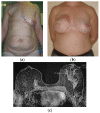Imaging of the Reconstructed Breast
- PMID: 37892007
- PMCID: PMC10605380
- DOI: 10.3390/diagnostics13203186
Imaging of the Reconstructed Breast
Abstract
The incidence of breast cancer and, therefore, the need for breast reconstruction are expected to increase. The many reconstructive options available and the changing aspects of the field make this a complex area of plastic surgery, requiring knowledge and expertise. Two major types of breast reconstruction can be distinguished: breast implants and autologous flaps. Both present advantages and disadvantages. Autologous fat grafting is also commonly used. MRI is the modality of choice for evaluating breast reconstruction. Knowledge of the type of reconstruction is preferable to provide the maximum amount of pertinent information and avoid false positives. Early complications include seroma, hematoma, and infection. Late complications depend on the type of reconstruction. Implant rupture and implant capsular contracture are frequently encountered. Depending on the implant type, specific MRI signs can be depicted. In the case of myocutaneous flap, fat necrosis, fibrosis, and vascular compromise represent the most common complications. Late cancer recurrence is much less common. Rarely reported late complications include breast-implant-associated large cell anaplastic lymphoma (BIA-ALCL) and, recently described and even rarer, breast-implant-associated squamous cell carcinoma (BIA-SCC). In this review article, the various types of breast reconstruction will be presented, with emphasis on pertinent imaging findings and complications.
Keywords: MRI of reconstructed breast; autologous reconstruction; breast; breast cancer recurrence; complications of reconstruction surgery; implant-based breast reconstruction.
Conflict of interest statement
The authors declare no conflict of interest.
Figures




















Similar articles
-
Breast Reconstruction Following Breast Implant-Associated Anaplastic Large Cell Lymphoma.Plast Reconstr Surg. 2019 Mar;143(3S A Review of Breast Implant-Associated Anaplastic Large Cell Lymphoma):51S-58S. doi: 10.1097/PRS.0000000000005569. Plast Reconstr Surg. 2019. PMID: 30817556
-
Zwitterionic polymer on silicone implants inhibits the bacteria-driven pathogenic mechanism and progress of breast implant-associated anaplastic large cell lymphoma.Acta Biomater. 2023 Nov;171:378-391. doi: 10.1016/j.actbio.2023.09.003. Epub 2023 Sep 7. Acta Biomater. 2023. PMID: 37683967
-
Management of complications following implant-based breast reconstruction: a narrative review.Ann Transl Med. 2023 Dec 20;11(12):416. doi: 10.21037/atm-23-1384. Epub 2023 Jul 12. Ann Transl Med. 2023. PMID: 38213810 Free PMC article. Review.
-
Breast implant-associated anaplastic large cell lymphoma: A comprehensive review.Cancer Treat Rev. 2020 Mar;84:101963. doi: 10.1016/j.ctrv.2020.101963. Epub 2020 Jan 13. Cancer Treat Rev. 2020. PMID: 31958739 Review.
-
Breast Implant-Associated Anaplastic Large-Cell Lymphoma in a Transgender Woman.Aesthet Surg J. 2017 Sep 1;37(8):NP83-NP87. doi: 10.1093/asj/sjx098. Aesthet Surg J. 2017. PMID: 29036941
References
-
- Sardanelli F., Trimboli R.M., Houssami N., Gilbert F.J., Helbich T.H., Alvarez Benito M., Balleyguier C., Bazzocchi M., Bult P., Calabrese M., et al. Magnetic resonance imaging before breast cancer surgery: Results of an observational multicenter international prospective analysis (MIPA) Eur. Radiol. 2022;32:1611–1623. doi: 10.1007/s00330-021-08240-x. - DOI - PMC - PubMed
Publication types
LinkOut - more resources
Full Text Sources
Research Materials

